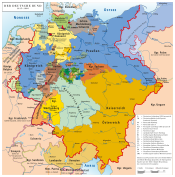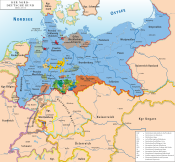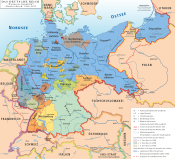History of the Free and Hanseatic City of Lübeck
This article needs additional citations for verification. (May 2010) |
Free and Hanseatic City of Lübeck Freie und Hansestadt Lübeck | |||||||
|---|---|---|---|---|---|---|---|
| 1226–1811 1815–1937 | |||||||
 Location of the Free City of Lübeck within the German Empire | |||||||
| Status | Free imperial city of the Holy Roman Empire Member of the German Confederation Member of the North German Confederation State of Germany (Empire) State of Germany (Weimar Republic) | ||||||
| Capital | Lübeck | ||||||
| Official languages | German | ||||||
| Government | Republic | ||||||
| History | |||||||
• Established | 1226 | ||||||
• Annexed by France | 1811 | ||||||
| 1815 | |||||||
| April 1 1937 | |||||||
| Area | |||||||
| 1905 | 297.7 km2 (114.9 sq mi) | ||||||
| Population | |||||||
• 1834 | 36,464 | ||||||
• 1871 | 52,158 | ||||||
• 1900 | 96,775 | ||||||
• 1933 | 136,413 | ||||||
| |||||||

The Free and Hanseatic City of Lübeck was a city-state from 1226 to 1937, in what is now the German states of Schleswig-Holstein and Mecklenburg-Vorpommern.[citation needed]
History
Imperial Free City and the Hanseatic League
In 1226 Emperor Frederick II declared the city of Lübeck to be an Imperial Free City. In the 14th century Lübeck became the "Queen of the Hanseatic League", being by far the largest and most powerful member of this medieval trade organization.
In 1359 Lübeck bought the ducal Herrschaft of Mölln from the indebted Duke Albert V of Saxe-Bergedorf-Mölln, a branch duchy of Saxe-Lauenburg. City and duke - after consenting with his brother Eric - stipulated a price of 9737.50 Lübeck marks. The parties agreed upon a repurchase, however, only by the duke or his heirs for themselves, but not as a middleperson for someone else.[1] Lübeck considered this acquisition crucial, since Mölln was an important stage for trade between Brunswick and Lunenburg - here especially salt - via Lübeck to Scandinavia and back. Therefore Lübeck manned Mölln with armed guards maintaining law and order on the roads.
In 1370 Lübeck further acquired - by way of pawn - the Herrschaft of Bergedorf, the Vierlande, half the Saxon Wood and Geesthacht from Duke Eric III, who had meanwhile succeeded his late brother Albert V.[2] This acquisition included much of the trade route between Hamburg and Lübeck, thus providing a safe way for freight between the cities. Eric III only refrained a life tenancy.
Lübeck and Eric III further stipulated, that once he would have died, Lübeck will be entitled to take possession of the pawns until his successors would repay the credit and simultaneously exercise the repurchase of Mölln, altogether amounting to the then enormous sum of 26,000 Lübeck Marks.[3]
In 1401 Eric III died without issue and was succeeded by his cousin of second degree Eric IV of Saxe-Ratzeburg-Lauenburg. In the same year Eric IV, supported by his sons Eric (later ruling as Eric V) and John, forcefully captured the pawned areas without any repayment, before Lübeck could take possession of them. Lübeck acquiesced.[4]
In 1420 Eric V attacked Prince-Elector Frederick I of Brandenburg and Lübeck gained Hamburg for a war alliance in support of Brandenburg. Armies of both cities opened a second front and conquered Bergedorf, Riepenburg castle and the Esslingen river toll station (today's Zollenspieker Ferry) within weeks. This forced Eric V to agree to the Peace of Perleberg on 23 August 1420, which stipulated that all the pawned areas, which Eric IV, Eric V and John IV had violently taken in 1401, were to be irrevocably ceded to the cities of Hamburg and Lübeck. The cities transformed the gained areas into the "Beiderstädtischer Besitz" (bi-urban condominium), ruled by bailiffs in four years terms, alternately staffed by one of the cities.
Several conflicts about trade privileges were fought by Lübeck and the Hanseatic League against Denmark with varying outcomes. While Lübeck and the Hanseatic League prevailed in conflicts in 1435 and 1512, Lübeck lost when it became involved in the Count's Feud, a civil war that raged in Denmark from 1534 to 1536. Lübeck also joined the Schmalkaldic League. After defeat in Count's Feud, Lübeck's power slowly declined. Lübeck managed to remain neutral in the Thirty Years' War, but with the devastation of the decades-long war and the new transatlantic orientation of European trade, the Hanseatic League and thus Lübeck lost importance. After the Hanseatic League was de facto disbanded in 1669, Lübeck stayed an important trading town on the Baltic Sea.
Full sovereignty in 1806
Lübeck remained a Free Imperial City even after the German Mediatisation in 1803 and became a sovereign state after the end of the Holy Roman Empire in 1806. During the War of the Fourth Coalition against Napoleon, troops under Bernadotte occupied the neutral Lübeck after a battle against Blücher on November 6, 1806.
First annexation
Under the Continental System, trade suffered and from 1811 to 1813 Lübeck was formally annexed as part of the First French Empire.
Reestablishment as sovereign state in 1813
Lübeck reassumed its pre-1811 status in 1813. The Vienna Congress of 1815 confirmed Lübeck's independence and it became one of 39 sovereign states of the German Confederation. Lübeck became part of the North German Confederation in 1867. In the following year Lübeck sold its share in the bi-urban condominium of Bergedorf to the Free and Hanseatic City of Hamburg, as well a sovereign state of the North German Confederation.[5] In 1871 Lübeck became an autonomous component state within the new-founded German Empire. This status was weakened during the Weimar Republic by enforcing the Reich's power to determine state and Reich's taxes. In 1933 in the course of the Gleichschaltung Lübeck's senate (the city government) and Bürgerschaft (parliament) were streamlined creating Nazi majorities. By 1935 the statehood of Lübeck, like all German states, had faded completely, without being formally suspended.
Second and final annexation
In 1937 the Nazis passed the Greater Hamburg Act, whereby the nearby Hanseatic City of Hamburg was expanded, to encompass towns that had formally belonged to the Prussian province of Schleswig-Holstein. To compensate Prussia, no less streamlined, for these losses (and partly because Hitler had a personal dislike for Lübeck), the 711-year-long statehood of Lübeck came to an end and almost all its territory was incorporated into Schleswig-Holstein.
Lübeck was occupied by the British Army the closing days of World War II. The Soviet Army later occupied all territory to the east of the city, as per the agreement of the Allied powers. Prussia was dissolved by the occupying Allied forces after the war, however unlike Hamburg and Bremen the statehood of Lübeck was not restored and the city was instead incorporated into the new federal state of Schleswig-Holstein. Lübeck's position on the inner German border, which cut off the city from much of its hinterland, was a key factor in this development.
See also
References
- ^ Elisabeth Raiser, Städtische Territorialpolitik im Mittelalter: eine vergleichende Untersuchung ihrer verschiedenen Formen am Beispiel Lübecks und Zürichs, Lübeck and Hamburg: Matthiesen, 1969, (Historische Studien; 406), p. 88, simultaneously: Hamburg, Univ., Diss., 1969.
- ^ Elisabeth Raiser, Städtische Territorialpolitik im Mittelalter: eine vergleichende Untersuchung ihrer verschiedenen Formen am Beispiel Lübecks und Zürichs, Lübeck and Hamburg: Matthiesen, 1969, (Historische Studien; 406), p. 90, simultaneously: Hamburg, Univ., Diss., 1969.
- ^ Elisabeth Raiser, Städtische Territorialpolitik im Mittelalter: eine vergleichende Untersuchung ihrer verschiedenen Formen am Beispiel Lübecks und Zürichs, Lübeck and Hamburg: Matthiesen, 1969, (Historische Studien; 406), pp. 90seq., simultaneously: Hamburg, Univ., Diss., 1969.
- ^ Elisabeth Raiser, Städtische Territorialpolitik im Mittelalter: eine vergleichende Untersuchung ihrer verschiedenen Formen am Beispiel Lübecks und Zürichs, Lübeck and Hamburg: Matthiesen, 1969, (Historische Studien; 406), p. 137, simultaneously: Hamburg, Univ., Diss., 1969.
- ^ Hamburg integrated the area into its state territory, making up most of its today Borough of Bergedorf.
- 1937 disestablishments
- States and territories established in 1226
- Lübeck
- History of Lübeck
- History of Mecklenburg-Vorpommern
- History of Schleswig-Holstein
- Imperial free cities
- States of the Holy Roman Empire
- States of the German Confederation
- States of the North German Confederation
- States of the German Empire
- States of the Weimar Republic
- Members of the Hanseatic League








